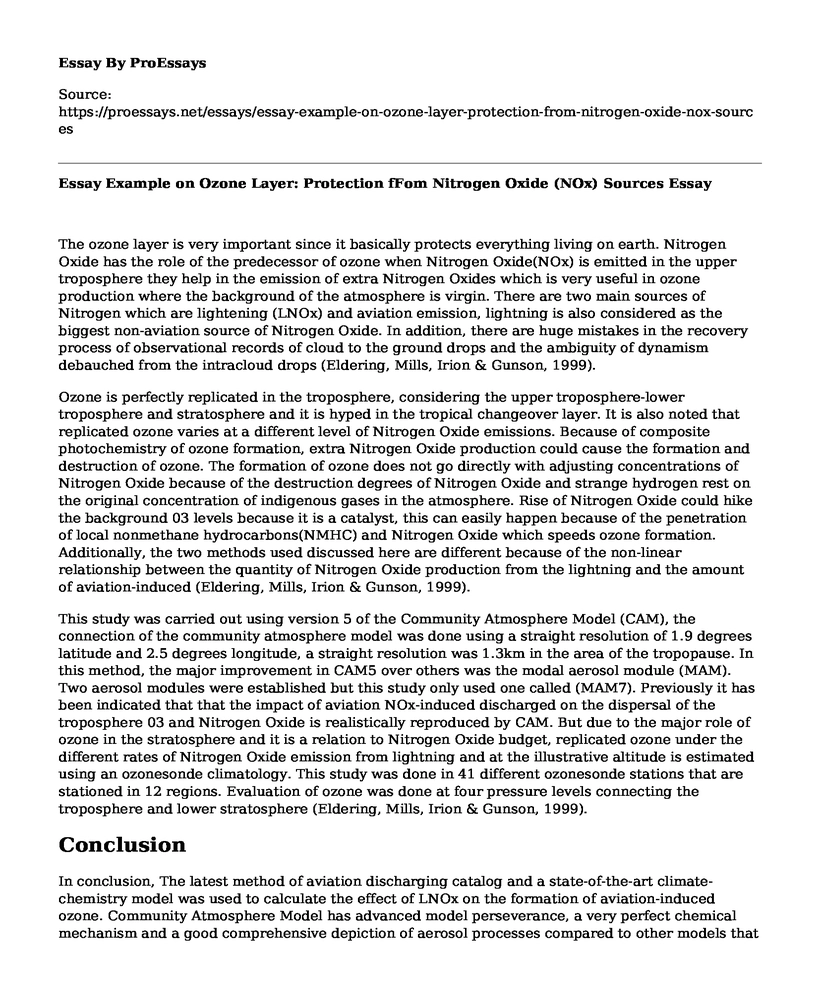The ozone layer is very important since it basically protects everything living on earth. Nitrogen Oxide has the role of the predecessor of ozone when Nitrogen Oxide(NOx) is emitted in the upper troposphere they help in the emission of extra Nitrogen Oxides which is very useful in ozone production where the background of the atmosphere is virgin. There are two main sources of Nitrogen which are lightening (LNOx) and aviation emission, lightning is also considered as the biggest non-aviation source of Nitrogen Oxide. In addition, there are huge mistakes in the recovery process of observational records of cloud to the ground drops and the ambiguity of dynamism debauched from the intracloud drops (Eldering, Mills, Irion & Gunson, 1999).
Ozone is perfectly replicated in the troposphere, considering the upper troposphere-lower troposphere and stratosphere and it is hyped in the tropical changeover layer. It is also noted that replicated ozone varies at a different level of Nitrogen Oxide emissions. Because of composite photochemistry of ozone formation, extra Nitrogen Oxide production could cause the formation and destruction of ozone. The formation of ozone does not go directly with adjusting concentrations of Nitrogen Oxide because of the destruction degrees of Nitrogen Oxide and strange hydrogen rest on the original concentration of indigenous gases in the atmosphere. Rise of Nitrogen Oxide could hike the background 03 levels because it is a catalyst, this can easily happen because of the penetration of local nonmethane hydrocarbons(NMHC) and Nitrogen Oxide which speeds ozone formation. Additionally, the two methods used discussed here are different because of the non-linear relationship between the quantity of Nitrogen Oxide production from the lightning and the amount of aviation-induced (Eldering, Mills, Irion & Gunson, 1999).
This study was carried out using version 5 of the Community Atmosphere Model (CAM), the connection of the community atmosphere model was done using a straight resolution of 1.9 degrees latitude and 2.5 degrees longitude, a straight resolution was 1.3km in the area of the tropopause. In this method, the major improvement in CAM5 over others was the modal aerosol module (MAM). Two aerosol modules were established but this study only used one called (MAM7). Previously it has been indicated that that the impact of aviation NOx-induced discharged on the dispersal of the troposphere 03 and Nitrogen Oxide is realistically reproduced by CAM. But due to the major role of ozone in the stratosphere and it is a relation to Nitrogen Oxide budget, replicated ozone under the different rates of Nitrogen Oxide emission from lightning and at the illustrative altitude is estimated using an ozonesonde climatology. This study was done in 41 different ozonesonde stations that are stationed in 12 regions. Evaluation of ozone was done at four pressure levels connecting the troposphere and lower stratosphere (Eldering, Mills, Irion & Gunson, 1999).
Conclusion
In conclusion, The latest method of aviation discharging catalog and a state-of-the-art climate-chemistry model was used to calculate the effect of LNOx on the formation of aviation-induced ozone. Community Atmosphere Model has advanced model perseverance, a very perfect chemical mechanism and a good comprehensive depiction of aerosol processes compared to other models that were utilized for calculating the effect of LNOx on the formation of aviation-induced ozone. Because of that, the results shown in this study are the latest evaluation of the effect of lightning Nitrogen Oxide on the production of aviation-induced ozone. There is some unpredictability in aviation-induced tropospheric ozone because of variances in the data demonstrations of the chemistry and physics of the original atmosphere in diverse models between which illustrations of Nitrogen Oxide discharge from lightning are a key one (Eldering, Mills, Irion & Gunson, 1999).
References
Eldering, A., Mills, F., Irion, F., & Gunson, M. (1999). Determination of stratospheric sulfate Aerosol composition and mass loading from high-resolution infrared transmission measurements. Journal Of Aerosol Science, 30, S571-S572. DOI: 10.1016/s0021-8502(99)80297-3
Cite this page
Essay Example on Ozone Layer: Protection fFom Nitrogen Oxide (NOx) Sources. (2023, Feb 27). Retrieved from https://proessays.net/essays/essay-example-on-ozone-layer-protection-from-nitrogen-oxide-nox-sources
If you are the original author of this essay and no longer wish to have it published on the ProEssays website, please click below to request its removal:
- Solar Energy and Wind Energy Discussion Paper Example
- Exploration of Soda Cans Annotated Bibliography
- Natural Disasters and Severe Weathers Paper Example
- Paper Example on Biodiversity and Ecology Foundations
- Essay Example on Street Refuse: Composition & Sources of Pollution
- Paper Example on Overfishing Threatens Marine Ecosystem and Seafood Security
- Air Pollution: A Global Health Risk of 2.94M Deaths/Year - Essay Sample







